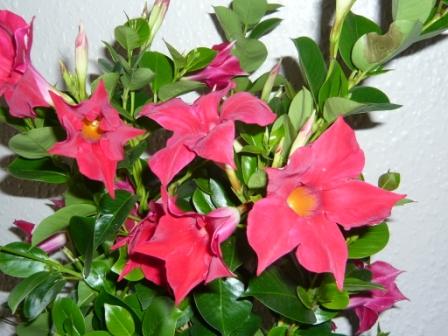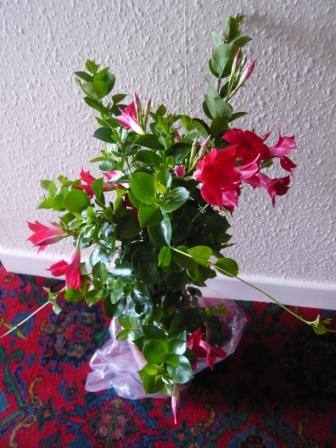
Mandevilla or Sundaville Conservatory & Houseplants
Mandevilla is marketed as a tender conservatory climbing plant.
They flower red or pink in summer on the current year’s growth. Prune in winter and keep at a temperature of at least 60ºF which may help the plant to stay evergreen. Mist in summer and water gently in winter.
Grow in good light in warm humid conditions and feed monthly.

What is in a Name Mandevilla or Sundaville
- The Mandevilla is a genus of plants from the tropics including Sanderi, Boliviensis and Amoena. They are woody climbing or trailing plants that will not survive frost.
- Sundaville is the Suntory trade mark for a new collection of red Mandevilla/ Dipladenia hybrids.
- Australian hybridisers have launched a new Mandevilla series called the Aloha range
RHS Recommended Varieties
- Mandevilla × amoena ‘Alice du Pont’ AGM (Syn: Mandevilla × amabilis): is a popular conservatory climber with large numbers of pink flowers in late summer. It reaches a height of up to 7m (22ft) and can tolerate temperatures of 10-15°C (50-59°F).
- M. laxa AGM (M. suaveolens, M. tweediana; Chilean jasmine): The selling point of this mandevilla is its strongly scented flowers of white or creamy-white. It can reach a height of 3-5m (10-15ft). It can survive short periods of temperatures down to 5°C (41°F).
- M. boliviensis AGM: At 3-4m (10-13ft), this is the least vigorous of those mentioned here and has white flowers with yellow eyes. Another one for the heated conservatory with minimum temperatures of 10-15°C (50-59°F).
- Mandevilla laxa – is hardy down to around 5°C
Photo and RHS Credits
Mandevilla (Dipladenia) by blumenbiene CC BY 2.0
Mandevilla novocapitalis by João de Deus Medeiros CC BY 2.0
Mandevilla Aloha Red – IMG_3276 by Degilbo CC BY-NC-ND 2.0 ‘Mandevilla (formerly Dipladenea) is a genus of climbing plants from Central and South America from subtropical regions. Interspecific breeding by Australian breeding duo Graham Brown and Mal Morgan has created an outstanding new Mandevilla series called the Aloha range which features continuous flowering between spring and autumn. ….’

Last Tips
Provide a trellis to support its vigorous, vine like climbing stems and tie loosely.
Trim or prune very weak stems.


